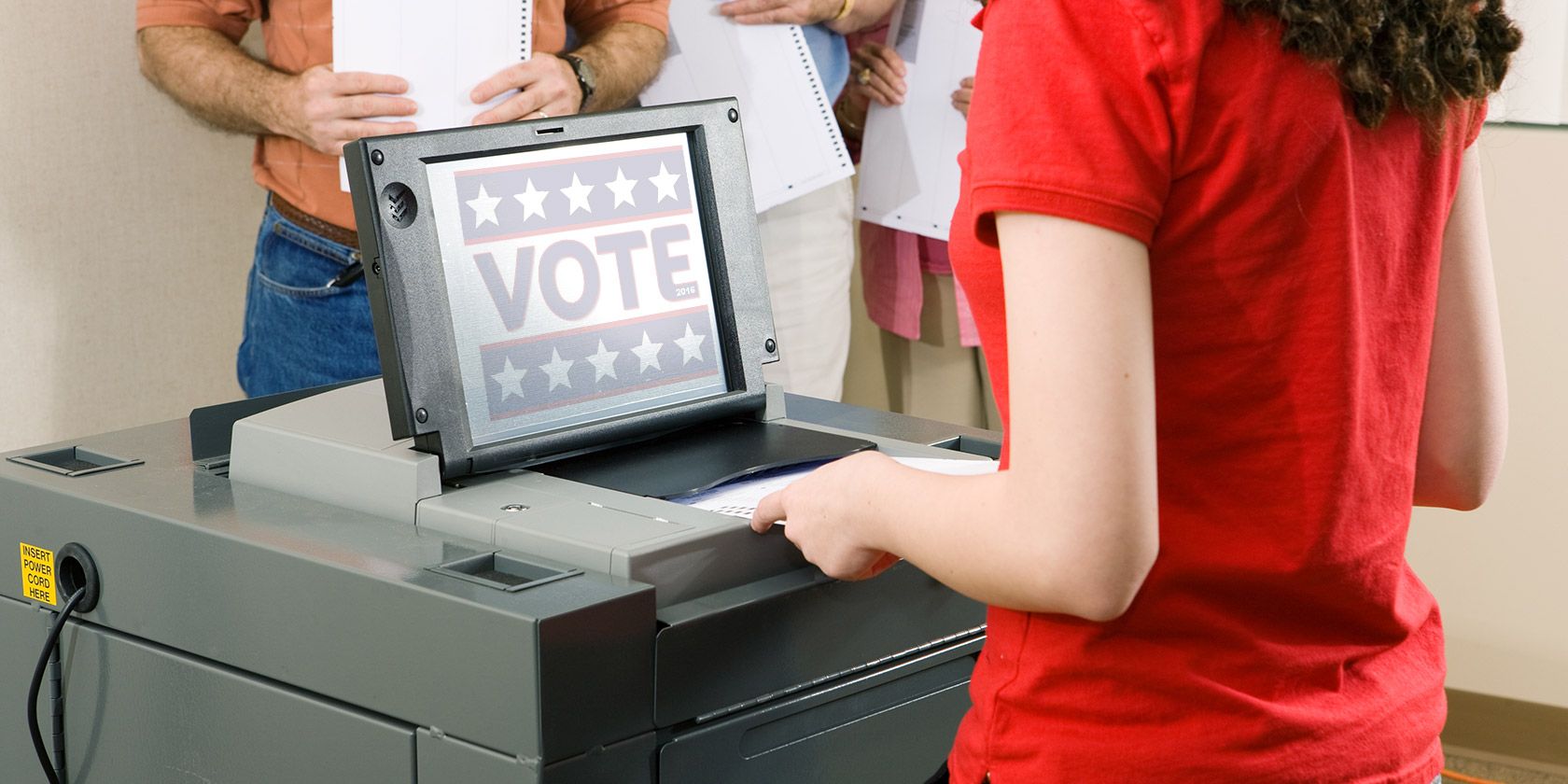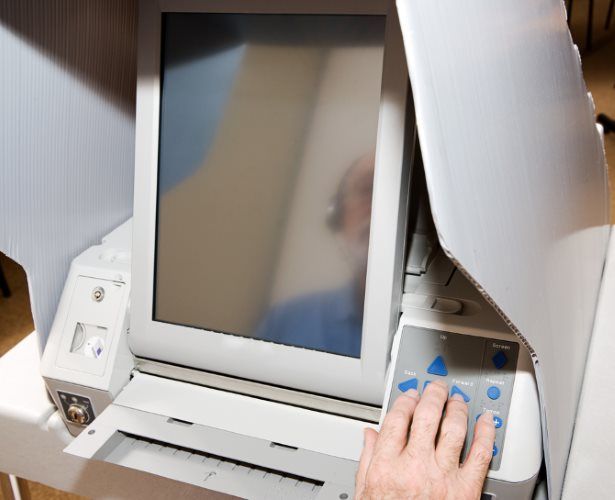How Electronic Voting Works: Pros and Cons vs. Paper Voting

In a world where your kettle can be connected to the internet, why is voting still done on paper? While voting from the comfort of your own home seems appealing, there are electronic voting pros and cons that have to be considered first.
Let’s take a look at what electronic voting is and if it can replace paper voting.
What Is Electronic Voting?
When you imagine how electronic voting works, you may picture tapping a touchscreen at an electronic voting machine (EVM) or casting your vote online. However, the term “electronic voting” covers much more than this.
Electronic voting involves any form of voting that uses modern technology to either cast or tally votes. Many polling locations in the United States have already made the switch by using scanner machines to count paper ballots.
So, why do we bother walking to the polling booth when we could just vote online? There are many advantages and disadvantages to electronic voting that need consideration before we use it to define a country’s future.
The Advantages of Electronic Voting

With the technology we have at our fingertips, it’s possible to set up a voting system for an entire country. There are several advantages of electronic voting that make voting easier than ever before.
Results Come in Faster With Electronic Voting
The primary advantage of an electronic voting machine is its speed. With traditional paper methods, ballots must be collected and counted from polling stations. This process is time-consuming and delays the final result.
In the United States, this delay typically keeps viewers up all night. With electronic voting, results are available almost instantly because votes are counted as they are cast. To calculate the final result, all the polling stations report their votes and they’re all added together. By using e-voting, the results of elections could be available in a matter of hours rather than days, meaning elections could have a more instantaneous impact.
Internet Voting Can Increase Attendance
Another major plus of electronic voting is voter engagement. Many people fail to take advantage of their right to elect their officials, even when Google begs them to vote. Advocates for e-voting argue that by offering an option to vote from home or work, more people would cast their votes.
Electronic voting also allows for greater accessibility to people with disabilities. Currently, someone unable to mark paper ballots requires an assistant to vote for them. This process compromises the person’s right to cast an anonymous ballot.
By bringing voting into the digital space, people who are unable to visit or use a polling booth can vote from home. This maintains anonymity and encourages the disabled and elderly to make their voices heard.
Electronic Voting Is More Cost-Effective in the Long Run
Finally, the last major advantage associated with e-voting is a long-term decrease in expenses. Paper votes require assistants that count and transport votes, which can add up as stations around the country tally up the results. These expenses could put a major strain on an entity like a small, underfunded local government.
Electronic ballot-counting machines can cut the cost of human counters, while internet voting can also cut out polling location employees. The infrastructure can be re-used every election, so it would be a one-time purchase.
The Disadvantages of Electronic Voting

Right now, the case for electronic voting seems strong. However, there are disadvantages to electronic voting that must be considered. While voting over the internet may seem convenient and easy, swapping to electronic voting may compromise the integrity of the political system.
Hackers Can Compromise Electronic Voting
By far, the biggest disadvantage of an electronic voting machine is election hacking. As with any electronic device, there is always the risk that someone could illegally alter the results of an election.
This could be done either through physical tampering or a remote attack over the internet. Allowing people to vote using their own devices could pose major risks as well. A malicious agent could change millions of electronic votes undetected. Changing that many paper ballots would be impossible not to notice.
Fraud Is Easier With Electronic Voting
Skeptics of the electronic voting solution claim that fraud can occur digitally. When going to a polling location, voters in most countries are required to provide a form of photo ID to confirm that they are the registered voter they claim to be. While fraud for in-person voting is possible, it requires a false photo ID, which is hard to come across.
With online voting, voter identification would have to occur with some other type of credential. This could include Social Security numbers, dates of birth, driver’s license numbers, or some other unique identifier.
The problem with using these types of verification is that anyone who obtains these pieces of information could log in and cast a vote for someone else. If someone obtained a large amount of these identifiers with a data breach, they would be able to cast thousands of fraudulent votes.
Manufacturer Bias Can Influence Votes
Another issue is how electronic voting systems are designed. These would be created and distributed by a private company, who will likely keep their source code locked away. Elections can have a huge effect on business, so company bias becomes an element when purchasing voting machines or systems.
When the government hires a company to implement its electronic voting machines, it’s trusting said company to accurately collect and report its votes. There’s no guarantee that this will occur, and many believe that no system should ever be implemented if it can’t guarantee fair and unbiased voting.
The Initial Costs for Digital Voting Is High
Finally, there’s the high upfront cost of installation. It would save in the long run, but the initial expenditure would be much larger than paper voting. Costs include the voting machines, maintenance and installation, testing the infrastructure, and securing the premises.
Is Electronic Voting Worth It?
While it may seem like the choice must be either traditional paper ballots or modern electronic voting, the truth is that there is a middle ground. There are plenty of advantages and disadvantages to EVMs, online voting, and paper voting. As such, the best solution is to mix traditional methods with digital ones, so that voters get the best of both worlds.
Some voting stations use scanner machines to read paper ballots to do all the hard work. If voters are overseas and can’t return to vote (for example, deployed soldiers,) there are systems that let them vote online. As such, it’s hard to say that one method is strictly better than the other. A system may be a perfect fit in one case but do poorly in another.
Because of this, it makes it almost impossible to say whether electronic voting is “better” than traditional paper voting. As technology advances, however, we may see digital voting replace paper voting as the superior way to make your voice heard.
Making the Voting Process Easier
Right now, electronic voting isn’t the perfect replacement for paper voting. There are many pros and cons to electronic voting, and the cons are currently too strong to replace paper voting. However, as these problems are ironed out, maybe we’ll all be voting in pajamas in the future.
If you want to delve deeper into politics, be sure to check out this site that shows accurate voting history and patterns for US politicians.
Read the full article: How Electronic Voting Works: Pros and Cons vs. Paper Voting
from MakeUseOf https://ift.tt/2poFKPq




No comments: